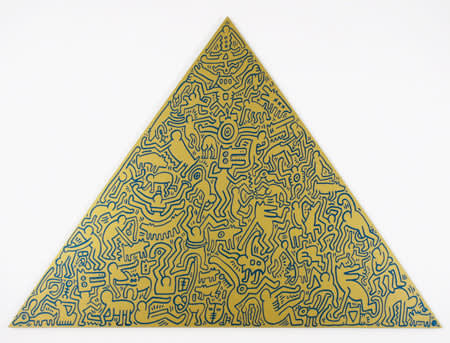Keith Haring fearlessly tackled the socio-political issues of his era in his art, standing against racism, homophobia, apartheid in South Africa, and AIDS. Despite delving into challenging themes, he infused his work with boundless energy and optimism. Influenced by New York City's graffiti and street art scene, he developed a distinctive style characterized by bold lines, vibrant colors and simplified forms, akin to urban hieroglyphs that spoke to a broad audience then and continue to do so after his death.
Keith Haring introduced the rare Pyramids in 1989, just one year before his death in February 1990. In the series, he created four silkscreens on anodized aluminum pyramids in a limited edition of 30, employing contrasting hues of blue, yellow, teal and gold to depict his trademark genderless, raceless and classless figures representing humanity's virtues and vices.
Keith Haring’s characteristic figures and symbols are depicted as the universal language of ciphers, celebrating life in an ecstatic dance. The opulent figures are arranged within the large pyramid shape to form an overarching, interwoven network against a single color background. Some of the linear figures and symbols are closely related to each other and are directly connected by lines, while others are solitary, organically shaped mosaic pieces, inserted into the lines of the surrounding figures. The unbelievable variety of these closely related figures and symbols embedded within each Pyramid is evidence of the highly geometric approach Keith Haring employed when conveying potent moral narratives in his work.
The Pyramids series gives Haring’s graffiti, originating from New York’s subway system, an elitist stage bringing together almost all the characters from his entire body of work. It epitomizes Haring’s use of modern hieroglyphics, drawing inspiration from ancient civilizations. Haring utilized pyramids as a recurring motif to create universally recognizable symbols, aiming for a lasting impact. Reflecting on the enduring legacy of ancient Egyptian pyramids, Haring's creations symbolize human resilience and imagination. Haring believed the pyramid symbolized an enigmatic force, perhaps once thought to harness energy.
Additionally, the pyramids served as a visual tool for Haring to confront societal marginalization, particularly evident in his portrayal of the AIDS epidemic's devastating impact. Through their imposing scale and provocative imagery, the pyramids compel viewers to confront these issues and incite action. Haring's dedication to activism extended beyond his art, as seen in his fundraising efforts for AIDS research. Including one such fundraiser hosted in memory of his friend martin burgoyne in 1986 at one of Haring's most frequented nightclubs, The Pyramid Club.





